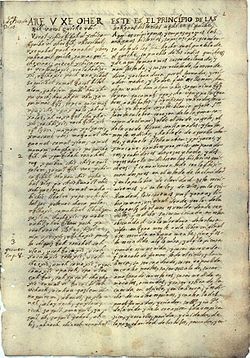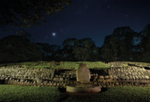Classical Kʼicheʼ was an ancestral form of today's Kʼicheʼ language (Quiché in the older Spanish-based orthography), which was spoken in the highland regions...
39 KB (3,738 words) - 20:06, 9 March 2025
low literacy rate, Kʼicheʼ is increasingly taught in schools and used on the radio. The most famous work in the Classical Kʼicheʼ language is the Popol...
34 KB (3,794 words) - 19:52, 10 February 2025
Kʼicheʼ (pronounced [kʼiˈtʃeʔ]; previous Spanish spelling: Quiché) are Indigenous peoples of the Americas and are one of the Maya peoples. The eponymous...
27 KB (2,710 words) - 18:31, 4 April 2025
postcolonial times both in Spanish and in indigenous languages such as Classical Kʼicheʼ and Kaqchikel. Important sources include the Popol Vuh which, apart...
24 KB (2,866 words) - 03:39, 9 April 2025
Mexico) Classical Quechua (lingua franca of the 16th-century Inca Empire) Classical Kʼicheʼ (a Mayan language of 16th-century Guatemala) Classical Tupi (language...
27 KB (3,249 words) - 20:47, 12 April 2025
Maya language spoken by the Kʼicheʼ people Classical Kʼicheʼ language, the 16th century form of the Kʼicheʼ language Kʼicheʼ Kingdom of Qʼumarkaj, a pre-Columbian...
463 bytes (82 words) - 03:12, 5 February 2023
document, Popol Vuh, is written in an antiquated Kʼicheʼ often called Classical Kʼicheʼ (or Quiché). The Kʼicheʼ culture was at its pinnacle at the time of...
94 KB (9,284 words) - 02:00, 26 March 2025
language spoken by the Kʼicheʼ people Classical Kʼicheʼ, the 16th century form of the Kʼicheʼ language Kʼicheʼ kingdom of Qʼumarkaj, a pre-Columbian state...
477 bytes (81 words) - 21:05, 22 February 2023
Achiʼ Qʼeqchiʼ (Kekchi) Pokom: Poqomam, Poqomchiʼ Uspantek Sakapultek Sipakapense See Mayan languages#Eastern branch for details. Classical Kʼicheʼ v t e...
1 KB (43 words) - 17:21, 16 February 2025
texts, including the Madrid Codex, the Kʼicheʼ epic Popol Vuh, the Kʼicheʼ Título de Totonicapán, the Kʼicheʼ language Rabinal Achi, the Annals of the...
41 KB (5,054 words) - 13:38, 30 December 2024
written in Classical Kʼicheʼ Maya. The ethnographical work in the Florentine Codex and the songs of the Cantares Mexicanos both written in Classical Nahuatl...
49 KB (5,331 words) - 00:31, 25 January 2025
Twins are the central figures of a narrative included within the colonial Kʼicheʼ document called Popol Vuh, and constituting the oldest Maya myth to have...
32 KB (4,593 words) - 14:39, 1 April 2025
municipalities. The inhabitants include Spanish-speaking Ladinos and the Kʼicheʼ and Mam Maya groups, both with their own Maya language. The department...
53 KB (4,411 words) - 22:48, 21 March 2025
by Arnold Schoenberg Popol Vuh Classical K'iche' Book of the People corpus of mytho-historical narratives of the K'iche' kingdom in Guatemala Porco Rosso...
27 KB (64 words) - 20:39, 10 January 2024
Nahuatl (section Dictionaries of Classical Nahuatl)
franca among merchants and elites in Mesoamerica, such as with the Maya Kʼicheʼ people. As Tenochtitlan grew to become the largest urban center in Central...
113 KB (12,652 words) - 12:14, 17 February 2025
(2001). Kikʼulmatajem le Kʼicheʼaabʼ: Evolución del Reino Kʼicheʼ [Evolution of the Kʼiche Kingdom] (in Spanish). Guatemala City, Guatemala: Cholsamaj...
187 KB (22,908 words) - 16:12, 5 February 2025
Classic Maya collapse (redirect from Classical Maya collapse)
such as Mayapán and Uxmal flourished, as did the Highland states of the Kʼicheʼ and Kaqchikel Maya. Independent Maya civilization continued until 1697...
42 KB (5,082 words) - 07:34, 5 April 2025
Takalik Abaj (category K'iche')
sculptured monuments. Tak'alik Ab'aj' means "standing stone" in the local Kʼicheʼ Maya language, combining the adjective tak'alik meaning "standing", and...
138 KB (16,434 words) - 21:02, 26 March 2025
time was Qʼumarkaj, also known as Utatlán, the capital of the aggressive Kʼicheʼ Maya kingdom. The government of Maya states, from the Yucatán to the Guatemalan...
60 KB (7,260 words) - 23:21, 28 February 2025
in the tzolk'in use other terms in their languages. For instance, the Kʼicheʼ use the term Aj Ilabal Qʼij [aχ ilaɓal qʼiχ] or Raj Ilabal Qʼij [ɾaχ ilaɓal...
30 KB (3,480 words) - 16:06, 16 January 2025
Theobroma cacao (category Articles containing Classical Nahuatl-language text)
the plant in indigenous Mesoamerican languages such as kakaw in Tzeltal, Kʼicheʼ and Classic Maya; kagaw in Sayula Popoluca; and cacahuatl in Nahuatl meaning...
43 KB (4,336 words) - 20:49, 21 March 2025
Kukulkan A Mayan mythological serpent. Q'uq'umatz A dragon from Mayan K'iche' mythology. Brazilian dragons Boitatá The name comes from the Old Tupi language...
45 KB (904 words) - 06:00, 14 February 2025
Thunderstone (folklore) (section Classical world)
weapons and implements were given to man by the Morning Star. Among the K'iche' people of Guatemala, there is a myth that a flint fell from the sky and...
13 KB (1,706 words) - 12:54, 11 April 2025
time was Qʼumarkaj, also known as Utatlán, the capital of the aggressive Kʼicheʼ Maya kingdom. The cities of the Postclassic highland Maya kingdoms fell...
30 KB (2,879 words) - 21:49, 3 February 2025
order to clearly distinguish it from all other Mayan languages (such as Kʼicheʼ and Itzaʼ). Thus, the use of the term Yucatec Maya to refer to the language...
46 KB (4,157 words) - 20:38, 29 March 2025
the population and is distributed into 23 groups namely Q'eqchi' 8.3%, K'iche 7.8%, Mam 4.4%, Kaqchikel 3%, Q'anjob'al 1.2%, Poqomchi' 1%, and Other 4%...
245 KB (24,749 words) - 07:37, 2 April 2025
Mesoamerican chronology (redirect from Maya Classical Era)
Archaeological zone of Tlatelolco, the Church on the ruins exemplifies the process of change from the post-classical period to the colonial period....
74 KB (8,856 words) - 02:18, 8 March 2025
Tezcatlipoca (category Articles containing Classical Nahuatl-language text)
Tezcatlipoca (Classical Nahuatl: Tēzcatlīpohca [teːs̻kat͡ɬiːˈpoʔkaˀ]) or Tezcatl Ipoca was a central deity in Aztec religion. He is associated with a...
33 KB (4,012 words) - 20:28, 14 January 2025
Charles Étienne Brasseur de Bourbourg (category Articles with K'iche'-language sources (quc))
of the Popol Vuh, a sacred book of the Quiché (Kʼicheʼ) Maya people. He included a grammar of the Kʼicheʼ language and an essay on Central American mythology...
23 KB (2,954 words) - 17:13, 2 April 2025
Indonesian Ido Interlingua Irish Italian Japanese4 Kannada Kazakh Klingon Kʼicheʼ Konkani Korean Kurdish Kyrgyz Quechua Latin Latgalian Latvian Lingua Franca...
20 KB (1,705 words) - 10:59, 27 March 2025


















